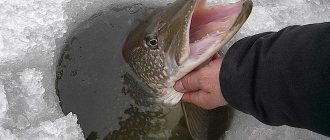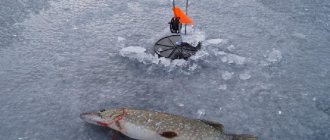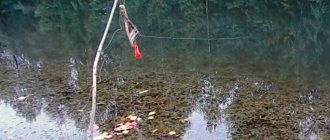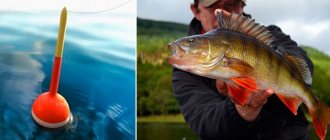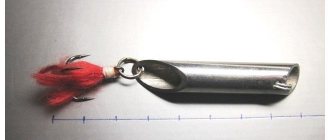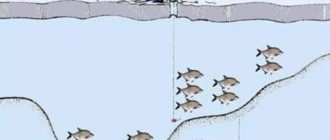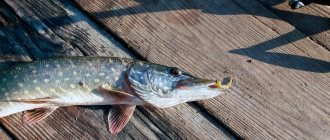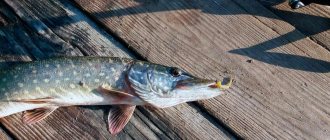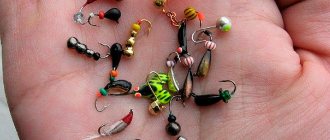Fishing with girders is one of the oldest methods of hunting for predatory fish, which was used by primitive fishermen. The tackle has reached our time as a more modernized fishing device, which, keeping pace with the advent of progressive modern materials, is still undergoing improvements and modifications today.
What is a zherlitsa
The essence of this gear is incredibly simple, and at first glance even primitive. A certain amount of thread equipped with a weight and a hook is wound on a base made of any available material. The bait on the hook is a live fish, which is preferred for consumption by the intended predator. A signal that the fish is interested in the device and pecked at the bait will be a change in the position of the thread. In most cases, this is its unwinding, which is visually noticed by the fisherman.
But as usually happens in life’s ups and downs, the initial primitiveness of a thing is brought by a person to the highest level of efficiency; only a lot of nuances are required to achieve success. It is from the nuances of experience accumulated over many centuries of using this gear that the skill and success of today’s fisherman is formed, and fishing with girders is an enjoyable and productive way of catching the vast majority of freshwater predators.
What types of vents are there?
We can safely say that few types of fishing tackle have such a huge variety in its manufacture. In our weather conditions and the sharp difference between the radically different seasons of open and closed water, it is reasonable to divide the gear into winter girders and use the term summer girder. This will make it easier, especially for a novice fisherman, to navigate all the technical diversity of the device.
Already based on the above-determined species series, it is possible to split the summer baits into pike on stationary poles, the so-called postavukhi, and into floating species, more familiar as circles. In winter, pike rigs are divided into above-ice options and under-ice rigs.
Where to look for pike on the river
Ice on rivers begins to melt earlier than on ponds and reservoirs. This is primarily due to the presence of a current. If the first edges appear on the site near fallen trees, reeds or islands, you need to go to them, observing all the rules of behavior on ice.
Fishing for pike in March on girders on the river will be most effective in these places. Here the water is richer in oxygen and there is more food, because peaceful fish also tend to the edges. If there are no such areas, you need to place the girders at the edge of the ice, again using extreme caution.
How to make a summer zherlitsa
Making a girder with your own hands, having an understanding of the principle of its operation, is not such a difficult task for any hardworking fisherman, and to a greater extent this category of people is like that.
It is clear that a homemade girder will most scrupulously satisfy the requirements of its owner’s gear. The material for the device can be either an ordinary wooden flyer that is not subject to technical progress, or modern types of materials, in particular rubber hoses and polyethylene pipes. These materials are not subject to corrosion, drying out and rotting, a fishing line can be easily run along them, and they are increasingly used by craftsmen as an original option - a do-it-yourself girder.
A stationary pole for pike in the summer is attached to wooden poles, which the fisherman needs to either prepare in advance or acquire them directly at the fishing site, which must be taken into account in the fishing strategy. The poles are installed on the shore or shallows of a reservoir in promising places and homemade poles are attached directly to them.
A fishing line is wound onto a pre-prepared reel made from the material proposed above; from fishing practice, I can confidently say that this is the best option for tackle both in winter and summer. A length of ten to fifteen meters of fishing line with a thickness of 0.3 mm is quite enough for any type of gear.
Important! A sliding sinker is used as a load. In the form of an olive, the most preferable option. The weight of the load in the range of 6–20 grams will ensure that the tackle is equipped with any type of live bait. The larger the bait, the heavier the load.
Making the right choice of leash and hook
After the load is threaded onto the fishing line, a bead bead is installed, which serves as a damper against breaking the knot, with which a leash, which is necessarily equipped with a swivel, is tied to the fishing line. Leashes are used in various lengths and from various materials. Their use depends on the possible size of the trophy and its predicted activity. The lower the activity of the predator, the more inconspicuous and thinner the leashes are used. I recommend 20 cm as a universal leash length. At this length, any live bait feels completely free.
A tee, double or single hook is also the prerogative of fishing conditions. But quick-detachable doubles with sizes corresponding to the size of live bait are more practical. A slot is made on the reel or flyer for mounting a stretched so-called charged fishing line. In case of a bite, the fish should easily pull the fishing line out of the slot, and the supply of fishing line should calmly fall to the water. This condition of the gear is a failure.
Floating girders
The easiest way to properly make a floating girder for pike in the summer is from dense polystyrene foam, or, in common parlance, polystyrene foam. The so-called circles are cut from this material no thicker than 2.5 cm. The optimal diameter is 15–20 cm. In the resulting circle, a slot is made along its circumference for laying fishing line. A hole is made in the center of the circle for a wooden or plastic pin. On one side of the pin a slot is made for the fishing line. The slot should allow the line to fall out without any hindrance. The pin length of 15 cm will satisfy any fishing conditions.
Important! The mugs are painted, on the one hand, red, and on the other hand, it is advisable to leave them in white. This makes the bite more noticeable.
The equipment does not differ from the stationary type of summer girder for pike. The fishing line with the nozzle is charged through a pin with a slot. The general appearance of the circle will look like the sail of a boat. When biting, the circle will turn over and the red color of the tackle will change to white. In this case, experienced fishermen say that the circle has gone out, it’s time to check it. In addition, I would advise that a spacious canvas bag for girders will not be a superfluous accessory at any time of the year.
As can be seen from the methods presented above, making gear does not imply a high-tech product and requires materials that are quite common these days, desire and a little free time. The catchability of summer girders made with your own hands will be discussed in the next section.
Installation, tactics and technique of fishing with a summer girder
Catching pike with a trap is a strategically interesting and exciting activity. Postavukhs are placed along the banks of the river in backwaters with a quiet current. It is preferable to place stakes or poles overhanging the algae thickets.
Important! Reliable fastening of the pole into the ground is one of the fundamental steps in installing gear.
Place baitfish at the border of clear water adjacent to vegetation. Place live bait no more than 40 cm from the bottom . When pike activity is low, live bait can be raised almost to the surface of the water. This method works especially well with the presence of wind ripples on the water surface.
Fishing for pike on girders in the fall becomes especially productive due to the greater activity of the fish, and during this period of the year mugs perform well. They can be launched either with the current and the wind, or installed in quiet places in the reservoir, sheltered from gusts of wind. A floating circle ensures that a large area of the reservoir can be fished, which naturally increases the chances of catching fish.
Important! Fishing with mugs requires the presence of a floating device, which is not required when fishing for pike with summer girders in a stationary location.
When the device is triggered, no special rush or fuss of the fisherman is required to lift the gear. Pike need time to swallow live bait. After this, it self-notches. The only negative point may be that the caught fish disappears into snags or thickets of underwater vegetation. Such a development of events may threaten the loss of equipment, so vigilance must be adequate. There are frequent cases of loss of a floating circle from being pulled under water by a large fish in a similar scenario - into thickets or snags.
Searching for pike on the pond
Fishing for pike in March using girders on a pond is also carried out near thickets of reeds, reeds or along the shore. If there are islands on a body of water, it makes sense to install gear near them.
Pay attention to the confluence of streams and springs. Their currents also carry oxygen, which attracts fish better than any bait.
It’s not worth looking for pike at depth in March. Most often it all stands on the shallows. And this applies not only to small grasses, but also to large individuals.
How to make a winter zherlitsa
Making a vent for the freeze-up period is also a very realistic idea. Winter homemade girders are no less diverse than their summer counterparts. Although initially I want to dwell on such a point as equipping a girder for pike in the winter.
Choosing fishing line in winter
Fundamentally, there will be no difference from the summer options both in terms of the volume of fishing line, and in terms of equipment with a load and selection of a leash. During this period of the year, I would only advise you to vary the color of the fishing line. After all, red wood on ice sprinkled with white snow is much more convenient to use than its colorless representative.
Read more about the nuances when choosing a winter fishing line. What you should pay attention to and what properties it should have.
What does the structure consist of?
The designs of over-ice stakes, which is what seasoned winter pikemen call them, can be divided into models with a platform and models without it. On a platform, most often made of plywood and painted with water-repellent paints, an ordinary fishing reel is mounted on a metal or plastic bracket. A slot is made in the platform to launch the fishing line into the hole.
One of the significant components of winter equipment is a bite alarm. It is a thin, rigid spring or elastic steel strip, with a fabric flag attached to the end. It is because of this striking feature that fishing in this way is often called using flags. The signaling device is attached to the platform or to the reel bracket in such a way that the design allows limiting the possibility of unwinding the reel with fishing line into the water from the force of the load and the live bait located on the equipment. But the force of restraining the reel should not interfere with a sharp pull-up, and therefore the fish’s bite, allowing the line to be safely dropped into the hole.
Important! The speed of rotation of the reel should not exceed the speed of dropping the line. Otherwise, the formation of overlaps in the loops of the fishing line will stall the reel and scare away the biting fish. For this case, a rubber casing is put on the axis of rotation of the reel or a counterweight is mounted on the handle of the reel and thus the movements of both elements are balanced.
In winter, it is convenient to fish on girders, especially on frosty days, with bets with a platform. This allows you to cover the holes not only from excessive light, but also to prevent them from freezing. But in a snowstorm and blizzard, betting on a high bracket without a platform looks preferable. She is less likely to be covered in snow, especially if it is a night trip, so in the morning it will take less time to find gear. But in order to completely avoid the possibility of the fishing line and platform freezing into the ice, fishermen developed an under-ice version of the bet. There was no need for much ingenuity here. The appearance of the summer representative of the tackle on a rubber hose is quite adaptable to an under-ice base.
Important! When installing a winter pole on a pike under the ice, mark the holes with poles.
Fishing with under-ice types of gear is less spectacular, but in terms of yield it is by no means inferior to fishing with flags.
Features of bait bait placement
If you want your baitfish to remain mobile for a long time, it needs to be mounted correctly. When fishing with girders, they usually do not use methods of baiting by the lips or nostrils. The most commonly used methods are:
- behind the back;
- by the tail;
- through the gills.
The most reliable way to attach live bait is the “back” method. It consists of using one of the stings of a tee or double to pierce the back of the baitfish between the ridge and the dorsal fin. This must be done with extreme caution: one wrong move, and your live bait will turn into a “dead man”.
The “through the gills” method involves dismantling the equipment before attaching the bait. The leash is unfastened from the fishing line, threaded through the fish’s mouth and one of the gills, and then pulled until the hook points touch the lips of the baitfish. Of course, this method cannot boast of either humaneness or longevity of the bait, but it provides reliable protection against it falling off the hook even during a predator attack.
For beginners in girder fishing, the “tail” method is perfect. It does not require injuring the fish, since the bait is fixed in a slightly different way. A piece of rubber band, for example from a balloon, is tightly placed on the tail of the live bait, and the sting is hooked onto it. This most “humane” method allows the bait to live as long as possible and behave naturally.
